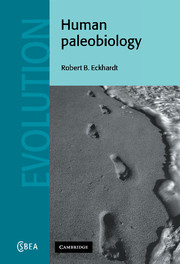Book contents
- Frontmatter
- Contents
- Preface
- Acknowledgments
- 1 Paleobiology: present perspectives on the past
- 2 Constancy and change: taxonomic uncertainty in a probabilistic world
- 3 A century of fossils
- 4 About a century of theory
- 5 Human adaptability present and past
- 6 Primate patterns of diversity and adaptation
- 7 Hominid phylogeny: morphological and molecular measures of diversity
- 8 Plio-Pleistocene hominids: the paleobiology of fragmented populations
- 9 Character state velocity in the emergence of more advanced hominids
- 10 The paleobiology of widely dispersed hominids
- 11 Paleobiological perspectives on modern human origins
- 12 A future for the past
- Bibliography
- Index
9 - Character state velocity in the emergence of more advanced hominids
Published online by Cambridge University Press: 18 December 2009
- Frontmatter
- Contents
- Preface
- Acknowledgments
- 1 Paleobiology: present perspectives on the past
- 2 Constancy and change: taxonomic uncertainty in a probabilistic world
- 3 A century of fossils
- 4 About a century of theory
- 5 Human adaptability present and past
- 6 Primate patterns of diversity and adaptation
- 7 Hominid phylogeny: morphological and molecular measures of diversity
- 8 Plio-Pleistocene hominids: the paleobiology of fragmented populations
- 9 Character state velocity in the emergence of more advanced hominids
- 10 The paleobiology of widely dispersed hominids
- 11 Paleobiological perspectives on modern human origins
- 12 A future for the past
- Bibliography
- Index
Summary
Introduction
During the Miocene, our ancestors had been part of an enormous network of hominoid populations distributed widely across tropical forests and more open woodlands that covered much of the Eurasian and African continents. Possibly as early as ten million years ago, but in any case by six to eight million years ago, climates changed and forests across those regions contracted. Somewhere in Africa clusters of ape populations crossed a transitional adaptive zone, becoming distinguished at first by ecology and behavior, and only later by genes and morphology. Their evolution followed a mosaic pattern, with one of the earliest recognizable components of hominid status being the functional complex including upright posture and bipedal locomotion, followed by craniodental changes and brain expansion. As we saw in Chapter 8, hominids evolved for four or five million years, producing morphologically diverse and adaptively successful populations that spread over East and South Africa. From among those groups, about which much is known but more is uncertain, biologically and behaviorally advanced hominids later arose.
Foley (1995) refers to the populations resulting from the first transition to upright posture as hominids, and reserves the term human only for the much later populations (circa 100000 to 150000 years ago) characterized by distinctive patterns of anatomical structure and behavior. Between the diverse and fragmented populations of earlier hominids and later populations that are recognizably human lies another zone of transition occupied by what many paleoanthropologists believe are members of the genus Homo who have not yet achieved fully human status. The formal taxonomic designation that traditionally has been applied to these transitional hominids is Homo habilis, though as noted below, this taxon is subdivided by some investigators.
- Type
- Chapter
- Information
- Human Paleobiology , pp. 208 - 234Publisher: Cambridge University PressPrint publication year: 2000



